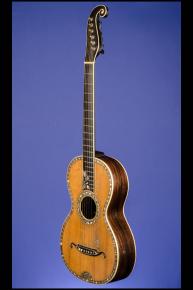A Wonderful Mid-Nineteenth Century Markneukirchen 'Stauffer-Style' Parlor Guitar.
1850 Markneukirchen 'Stauffer-Style' Parlor Guitar - 12 fret to body with 'Roses' and 'Fantail' Inlays.
This 1850s Markneukirchen "Stauffer Style" 'Parlor' guitar weighs just 2.60 lbs. and has a 11 3/4 inch wide and 3 1/2 inch deep South American Zebrawood, ladder-braced' body with a natural spruce top. The body depth at the neck is 2 3/4 inches, the upper bout measures 9 1/4 inches and the body length is 17 1/8 inches. The sound hole has a diameter of 3 1/8 inches and is bound with white pyralin, surrounded by three circular 'Herringbone' inlays and the most intricate floral inlay ring (3/8 inch wide) of mother-of-pearl and abalone. The edge of the top also has a 5/16 inch floral inlay of mother-of-pearl and abalone and has Herringbone strips and a single layer of pyralin. At the strap-end of the top is a beautiful 'Fantail' inlay of mother-of-pearl and abalone. The back of the guitar has a 1/8 inch Herringbone border and two thin maple center-strips. The sides also have a thin maple strip on the top and another on the bottom. On the strap-button edge of the body the ivory pin is flanked each side by a 3/16 inch marquetry strip.
Ebonized maple neck with 'ice-cream cone' heel and a scale length of 24 1/2 inches. The nut width is just under 1 7/8 inches and the 'D' neck profile is nice and thin with 0.83 inches at the first fret and just 0.88 inches at the ninth fret. Staufer style ebonized single bound maple 'scroll' peghead with non-original straight-through tuners with rear-facing oval ebony buttons. On the back of the peghead is the fine silver engraved tuner mechanism cover with twelve screws (two missing). Single pyralin bound ebony fretboard with nineteen original? thin frets and neck joint at twelfth fret. From the thirteenth, the length of the frets gradually shortens on the bass side. In this space is the most beautiful 'Rose' inlay of mother-of-pearl and abalone.
Original? metal saddle on 'Moustache' shaped ebony tailpiece with very intricate inlaid mother-of-pearl and abalone ornamentation including two heart shaped inlays of Abalone at each end. Six ivory pins (some not original) with inlaid abalone circles. (Martin called this type of bridge "bridge with little hearts").
There are five cracks on the top and two on the sides which have now been repaired and are perfectly stable. There are just two (out of eighty-one) 'floral' abalone inlays missing on the top just by the bass side waist. The action at the twelfth fret is a little high at just under 3/16 inch. There is some playing wear on the top but overall this two hundred year old guitar is in truly amazing condition.
Housed in a modern five-latch, shaped black hardshell case with burgundy plush lining (9.25).
This actual guitar from the world famous Chinery collection is featured in Gruhn & Carter's Acoustic Guitars and other Fretted Instruments, pp. 9-11 with two color photographs. "Unlabeled, early 1800s. Though unlabeled, this guitar (shown in detail on page 9) has some diistinct Staufer characteristics. The scroll peghead is typical of Staufer and other German makers. This example has straight-through tuners (non-original) without the long shafts typical of Staufer's six-on-a-side tuner configuration. Floral inlay was available from German suppliers in precut form, and it appears on many guitars of this period. Herringbone trim is associated with Staufer's most famous protégé, C.F. Martin. Brazilian rosewood would also be Martin's choice for backs and sides. Pyramid/BM"
"C.F. Martin Sr. (1796-1873 worked for guitar-maker Johann Stauffer of Vienna - and, not surprisingly, a Stauffer guitar from circa 1820 looks very much like the early Martins, with its scrolled headstock, six-on-a-side tuner unit, 'moustache' bridge ends, and relatively large upper bout. Martin & Schatz guitars were either made or marketed with Martin's friend from Markneukirchen, Heinrich Schatz, whom Martin followed to the United States in 1833 and who may have had an influence in the development of X-pattern bracing. When Schatz moved to eastern Pennsylvania in 1835, Martin again followed him, buying a home that still stands today in Cherry Hill, just outside of Nazareth." (Walter Carter. The Martin Book, p.19).
Peter Szego, in his new book Inventing The American Guitar, shows a far less ornate Martin & Schatz example ca. 1835-37 with almost identical measurements and bracing (page 41).














